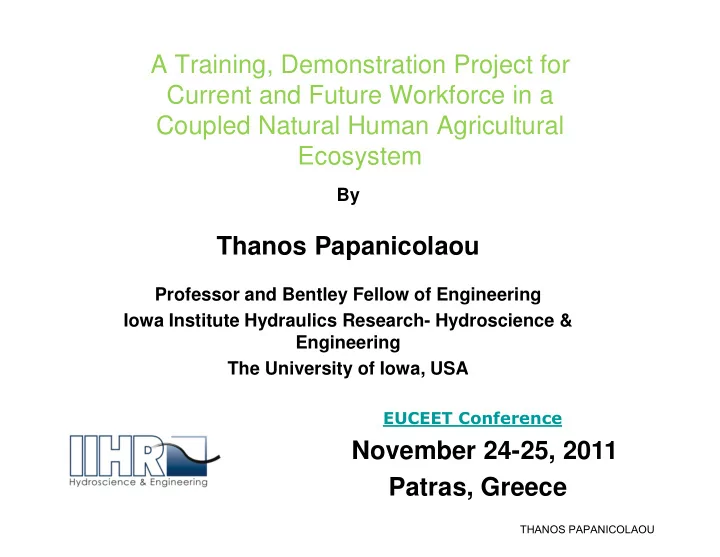

A Training, Demonstration Project for Current and Future Workforce in a Coupled Natural Human Agricultural Ecosystem By Thanos Papanicolaou Professor and Bentley Fellow of Engineering Iowa Institute Hydraulics Research- Hydroscience & Engineering The University of Iowa, USA ����������������� November 24-25, 2011 Patras, Greece THANOS PAPANICOLAOU
“ We should not knowingly allow any species or race to go extinct. And let us go beyond mere salvage to begin the restoration of natural environments, in order to enlarge wild populations and stanch the hemorrhaging of biological wealth. There can be no purpose more enspiriting than to begin the age of restoration, reweaving the wondrous diversity of life that still surrounds us.” E.O. Wilson, Restoration Ecologist THANOS PAPANICOLAOU
Outline This course is a senior level course in the engineering curriculum and focuses on: • Part I: Fundamentals of River Restoration-in class • Part II: Examples of River Restoration-hands on experience • Part III: Methodological Steps of River Restoration-design project THANOS PAPANICOLAOU
In-class • We provide a brief overview of the natural channel design method for river restoration. This intends to build respect for the science and complexity behind river restoration using natural channel design procedures. THANOS PAPANICOLAOU
Introduction • Restoration - return of a degraded ecosystem to a close approximation of its remaining natural potential (USEPA, 2000) THANOS PAPANICOLAOU
Introduction • Ecological restoration- the process of assisting the recovery of an ecosystem that has been degraded, damaged, or destroyed (Society for Ecological Restoration (SER) International Science and Policy Working Group, 2004) �������������������������������������������������������������� ������������������������������������������������ THANOS PAPANICOLAOU
Objectives Goals of Restoration Projects Restore and maintain biodiversity values and enhance functions of natural systems. These include: 1. Physical: Hydrologic & geologic 2. Chemical: Water quality improvement 3. Biological: Habitat (optimal & diverse) 4. Society Value: Recreation & aesthetics THANOS PAPANICOLAOU
Phase I: In-class Phase I: Restoration Goal/Objectives – Define specific restoration objectives associated with physical, biological and chemical process. The following are common objectives: a) reduce flood levels; b) stabilize streambanks; c) reduce sediment supply, land loss and attached nutrients; d) improve visual values; e) improve fish habitat and biological diversity; f) create a “naturally stable” river; g) withstand floods; h) provide for self-maintenance; i) be cost-effective; j) improve water quality; and k) improve or create wetlands. THANOS PAPANICOLAOU
Phase II: hands-on experience Phase II: Regional and Local relations - Develop regional and localized specific information on geomorphologic characterization, hydrology and hydraulics. During Phase II, it is important to incorporate information on valley types, stream types and reference reach data representing the stable form in similar valley types. Preparation should include assessing regional hydrology curves (bankfull discharge and cross-sectional area versus drainage area) (Rosgen and Silvey, 2005) and hydraulic calculations and validation at gage stations using resistance relations and/or roughness values. THANOS PAPANICOLAOU
Phase II: Method • Associated problems THANOS PAPANICOLAOU
Phase II: Method • River information THANOS PAPANICOLAOU
Phase III Design Projects Phase III: Watershed/River Assessment – Conduct a watershed/river assessment to determine river potential, current state and the nature, magnitude, direction, duration and consequences of change (Watershed Assessment and River Stability for Sediment Supply (WARSSS), Rosgen, 1999, 2006). Phase III assesses the causes and consequences of change at both the micro and macro levels. During this phase, it is important to: a) review land use history and time-trends of river change; b) isolate the primary causes of instability and/or loss of physical and biological function; c) collect and analyze field data, including reference reach data, to define sedimentological, hydraulic and morphological parameters; d) obtain concurrent biological data (limiting factor analysis) on a parallel track with the physical data; and e) quantify streamflow and sediment regime changes. THANOS PAPANICOLAOU
Method • A typical multi purpose strembank erosion control structure THANOS PAPANICOLAOU
Method Phase VIII: Monitoring and Maintenance Plan – Design a plan for effectiveness, validation and implementation monitoring to ensure stated objectives is met, prediction methods are appropriate and construction is implemented as designed . Deposition processes after barbs construction THANOS PAPANICOLAOU
Introduction Fig. 1b. Typical cross sectional area before and after 1950. THANOS PAPANICOLAOU
Methodology Field measurements (Study site): . Site and equipment: a) general view; b) Nebraska gage station; c) Aerial map near a dike; d) eddy currents developed behind the dikes; e) the LSPIV truck; f) Tunnel hull Jon boat and ADCP setup. THANOS PAPANICOLAOU
Methodology Field measurements (Study site): General view for the site under consideration and lactations of the ADCP measurements. THANOS PAPANICOLAOU
Methodology Field measurements: Depth-averaged velocity vectors and free surface flow field around the downstream dike from field measurements. THANOS PAPANICOLAOU
Summary and Conclusions • Students benefit by interacting with the Corps of Engineers, USGS and other agencies. • Students use this project for meeting their writing degree requirements • Teaching is not disconnected from practice • Ways of improving the course: – Increase field excursions – Find funding from private sector to support – Student contribution should remain to $70 per semester for this course. THANOS PAPANICOLAOU
Questions? THANOS PAPANICOLAOU
Recommend
More recommend